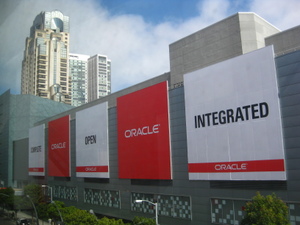With Oracle now in a self-imposed “quiet period” prior to its next quarterly earnings release, it’s not likely the company will make any major announcements until its OpenWorld conference, which kicks off at the end of September.
Given the ever-increasing size and scope of Oracle’s product offerings, the conference is sure to be a news-packed affair. Here are some educated guesses about what Oracle will, and perhaps should announce at the show.
A beta program for Oracle’s next-generation database?
Despite Oracle’s forays into new areas such as hardware and ever-increasing types of business applications, the database it was originally founded upon remains a crucial asset. Oracle CEO Larry Ellison has already revealed that the company plans to unveil a long-awaited new version and successor to release 11g in December or January.
OpenWorld, therefore, could be the perfect place to announce some type of beta program for the new edition, which is expected to be called 12c, with the “c” denoting “cloud.”
Oracle hasn’t made public any details of the new features in 12c, but in a recent interview, database industry analyst Curt Monash offered some speculation.
“I wonder whether Oracle will finally introduce a true columnar storage option, a year behind Teradata,” Monash said. “That would be the obvious enhancement on the data warehousing side, if they can pull it off. And given the datatype extensibility that dates back to the 1990s, they should be able to. If they can’t, it’s a damning commentary on the core Oracle codebase.”
Oracle may also have built in “something that it portrays as good multi-tenancy support,” he added. In addition, “anything that makes schema change easier could be a win on the DBA and multi-tenancy side alike,” Monash said.
Will Oracle’s family of ‘engineered systems’ grow?
Beginning with the Exadata database machine in 2008, Oracle has released a series of appliances, which it deems “engineered systems,” that combine hardware, networking equipment and storage with stacks of its software. This approach results in higher performance and a single point of accountability for customers, Oracle contends.
Last year at OpenWorld, it debuted two new systems, Exalytics and the Big Data Appliance. It’s not clear whether the vendor plans to debut yet another new flavour of engineered system this year, and it already recently announced a major upgrade to the software stack that runs its Exalogic application-server machine.
One possibility, then, would be a new version or versions of Exadata. “On Exadata, assume that Oracle is always looking to improve how data gets allocated among disk, flash and RAM,” Monash said.
OpenWorld show-goers will at the very least get a sneak peek at the product’s road map, according to information in the online session catalogue.
The show would also be a good time for Oracle to make a key announcement for its other hardware products, such as the SPARC-based M-Series and T-Series servers, said Eric Guyer, a consultant who helps clients negotiate deals with the company.
“[Co-President] Mark Hurd has been saying he wants the most profitable channel in the industry, which nobody really believes,” Guyer said.
Therefore, it would be good for Oracle to loosen up on its past statement that it would sell directly to its 2,000 largest customers, and let hardware resellers in on more of the action, he added. “I don’t think they’re going to do that, but I think they need to do that to be successful, if they’re going to be in the SPARC business.”
Can Oracle clear up its cloud confusion?
Oracle initially announced its Public Cloud service at last year’s OpenWorld, and followed that up with a launch event in June. But it’s still not clear when all of its offerings, which include a Java PaaS (platform as a service), cloud version of Oracle’s database and the full range of Oracle’s next-generation Fusion Applications will be generally available.
Nor has Oracle provided public pricing for its cloud products, although it has said that they will use a subscription model, which is common in cloud services.
“I’d like to see them now say not that ‘it’s done,’ but, ‘here’s the price,'” Guyer said.
Oracle, long used to the steady predictability of on-premise license sales and annual maintenance revenue, may be having a tough time figuring out how to price the applications via subscription for the mass market in a way that preserves its profitability. But it may end up solving the riddle by the time OpenWorld rolls around.
One thing is for sure: “Everything they sell they want to be able to deliver in a cloud delivery model,” said Forrester Research vice president Paul Hamerman.
While Oracle will feature some announcements for older products such as PeopleSoft, “most of the keynote-level stuff will be around cloud-based offerings,” especially Fusion Applications, he added.
“I think by OpenWorld they’re going to be able to tout a decent number of live customers [for Fusion Applications], some brand-name companies,” Hamerman said. “Enough so they can leverage that and encourage more customers to go in that direction.”






